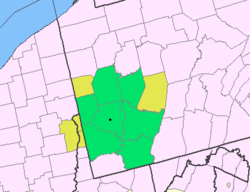Experimental Mine, U.S. Bureau of Mines | |
 Dedication of the Experimental Mine, 1910. | |
| Location | South of Bruceton, off Cochran Mill Rd. |
|---|---|
| Nearest city | Bruceton, Pennsylvania |
| Coordinates | 40°18′18.08″N79°58′51.49″W / 40.3050222°N 79.9809694°W |
| Built | 1910 |
| Architect | U.S. Bureau of Mines |
| NRHP reference No. | 74001732 [1] |
| Added to NRHP | October 18, 1974 |
Experimental Mine, U.S. Bureau of Mines is a landmark located in the Pittsburgh suburb of Bruceton, Pennsylvania. In 1910, the newly created U.S. Bureau of Mines leased a 38-acre tract of land from the Pittsburgh Coal Company and opened the Experimental Mine. [2]
Contents
One of the early findings in the Experimental Mine demonstrated that coal dust by itself was capable of propagating an explosion even in the absence of any methane gas. This demonstration was contrary to the old belief widely held at the time that coal dust could not explode without gas. This view had led to the very dangerous and widespread practice of using loose coal dust in mines to pack explosives in boreholes, which had cost many thousands of lives. These early experiments clearly proved that such a practice was too hazardous to continue. [3] [4] [5]





